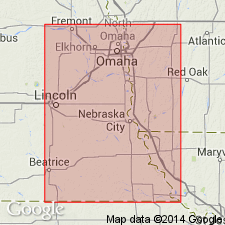
- Usage in publication:
-
- Haynies limestone bed
- Modifications:
-
- Original reference
- Dominant lithology:
-
- Limestone
- AAPG geologic province:
-
- Forest City basin
Summary:
Pg. 40, 43, 49, 50. Haynies limestone bed of Deer Creek limestone member of Shawnee formation. Haynies limestone, 8 inches to 1 foot thick in southeast Nebraska, 9 inches in southwest Iowa, 1 foot-8 inches in northwest Missouri, and 2+ feet in northeast Kansas. Underlies Mission Creek shale and overlies Larsh shale, all included in Deer Creek limestone. Age is Late Pennsylvanian (Missouri age). Report includes cross sections, measured sections, geologic maps, stratigraphic tables.
Outcrop at foot of Missouri River bluffs southeast of Haynies Station, Mills Co., southwestern IA.
Source: US geologic names lexicons (USGS Bull. 896, p. 930; USGS Bull. 1200, p. 1712-1713); GNC KS-NE Pennsylvanian Corr. Chart, sheet 1, Oct. 1936; supplemental information from GNU records (USGS DDS-6; Denver GNULEX).
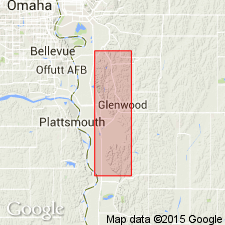
- Usage in publication:
-
- Haynies limestone member
- Modifications:
-
- Not used
Summary:
Used Plummer limestone, in Iowa, for the beds formerly called Haynies limestone, and stated (p. 5): The "Haynies limestone" member of the Deer Creek, according to Condra and Moore, is the Plummer limestone of Oklahoma.
Source: US geologic names lexicon (USGS Bull. 896, p. 930); GNC KS-NE Pennsylvanian Corr. Chart, sheet 2, Oct. 1936.
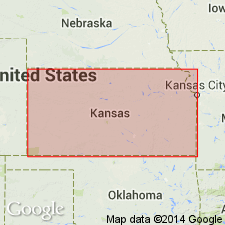
- Usage in publication:
-
- Haynies member
- Modifications:
-
- Not used
Summary:
Pg. 186. Haynies member seems exactly to correspond to upper bed of Plummer limestone as originally defined, and it is possible Rock Bluff limestone, Larsh shale, and Haynies limestone together are = original Plummer limestone. [On p. 187 he stated:] Because shale between Ervine Creek limestone and Rock Bluff limestone in Kansas appears to be exactly = Larsh shale, Haynies limestone, and Mission Creek shale of Nebraska it is here called [/]Larsh-Mission Creek shale member of Deer Creek limestone. It is 2.5 to 7 feet thick. [He omitted Haynies limestone from this 1936 classification for Kansas.]
[GNC remark (ca. 1936, US geologic names lexicon, USGS Bull. 896, p. 930): See "Modern classifications of the Pennsylvanian rocks of eastern Kansas and southeastern Nebraska," compiled by M.G. Wilmarth, Secretary of Committee on Geologic Names, USGS unpub. corr. chart, Oct. 1936, sheet 2. Also see 1937 entry under Topeka limestone for Condra's latest views.]
[The use of a hyphen between undifferentiated [members] is not considered proper notation (CSN, 1933).]
Source: US geologic names lexicon (USGS Bull. 896, p. 930); GNC KS-NE Pennsylvanian Corr. Chart, sheet 2, Oct. 1936.
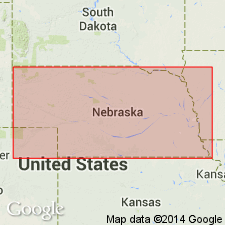
- Usage in publication:
-
- Haynies limestone member
- Modifications:
-
- Overview
Summary:
Haynies limestone member of Deer Creek limestone. Underlies Burroak shale member; overlies Larsh shale member. Age is Late Pennsylvanian (Virgil). [Not treated as a subdivision of Deer Creek by the Kansas Geol. Survey.]
Source: US geologic names lexicon (USGS Bull. 1200, p. 1712-1713).
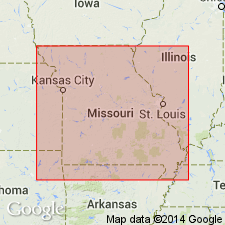
- Usage in publication:
-
- Haynies limestone member
- Modifications:
-
- Areal extent
Summary:
Pg. 18. In Missouri, uppermost limestone of Deer Creek may include Haynies limestone member.
Source: US geologic names lexicon (USGS Bull. 1200, p. 1712-1713).
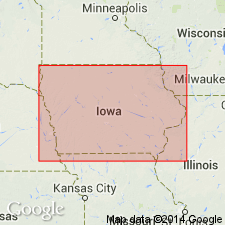
- Usage in publication:
-
- Haynies limestone member
- Modifications:
-
- Areal extent
Summary:
Pg. 17-18, fig. 5. Haynies limestone member of Deer Creek limestone. Well exposed in outcrops and quarries near Pacific Junction, Mills County, southwestern Iowa, where it is a single massive bed, dark-gray, argillaceous, and fossiliferous. Thickness 1 foot or less. Underlies Burroak shale; overlies Larsh shale. Where Haynies is absent Burroak and Larsh shales coalesce and are difficult to differentiate. Age is Late Pennsylvanian (Virgilian).
Source: US geologic names lexicon (USGS Bull. 1200, p. 1712-1713).
For more information, please contact Nancy Stamm, Geologic Names Committee Secretary.
Asterisk (*) indicates published by U.S. Geological Survey authors.
"No current usage" (†) implies that a name has been abandoned or has fallen into disuse. Former usage and, if known, replacement name given in parentheses ( ).
Slash (/) indicates name conflicts with nomenclatural guidelines (CSN, 1933; ACSN, 1961, 1970; NACSN, 1983, 2005, 2021). May be explained within brackets ([ ]).

